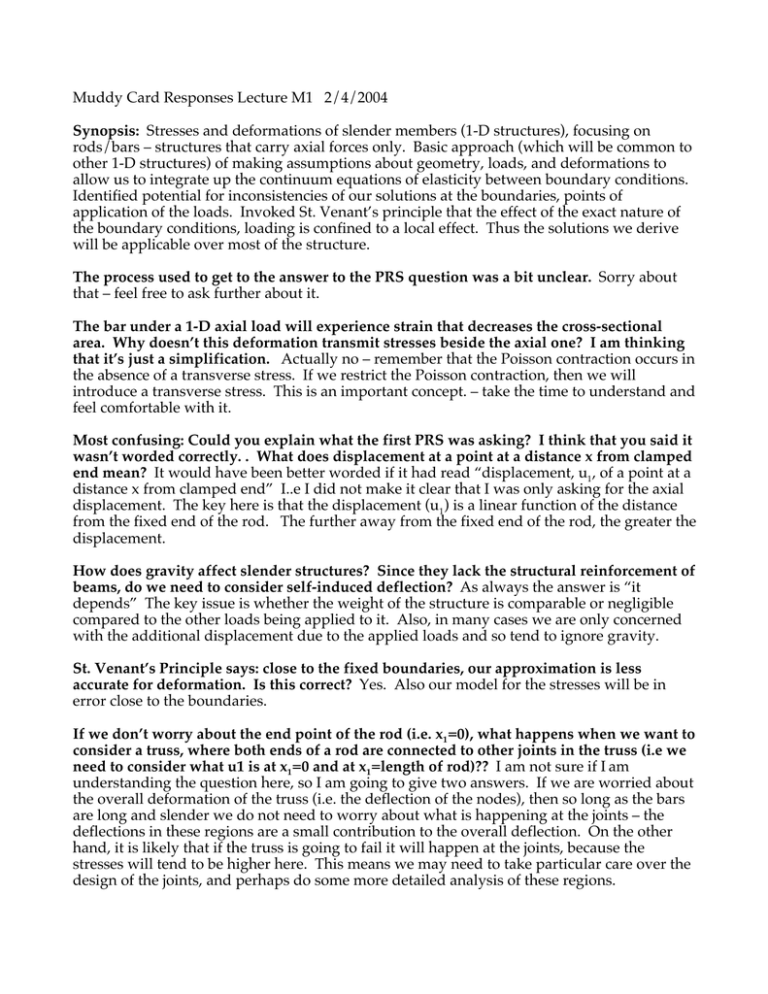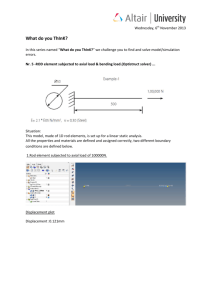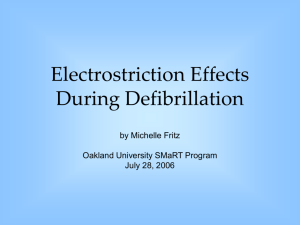Muddy Card Responses Lecture M1 2/4/2004 Synopsis:
advertisement

Muddy Card Responses Lecture M1 2/4/2004 Synopsis: Stresses and deformations of slender members (1-D structures), focusing on rods/bars – structures that carry axial forces only. Basic approach (which will be common to other 1-D structures) of making assumptions about geometry, loads, and deformations to allow us to integrate up the continuum equations of elasticity between boundary conditions. Identified potential for inconsistencies of our solutions at the boundaries, points of application of the loads. Invoked St. Venant’s principle that the effect of the exact nature of the boundary conditions, loading is confined to a local effect. Thus the solutions we derive will be applicable over most of the structure. The process used to get to the answer to the PRS question was a bit unclear. Sorry about that – feel free to ask further about it. The bar under a 1-D axial load will experience strain that decreases the cross-sectional area. Why doesn’t this deformation transmit stresses beside the axial one? I am thinking that it’s just a simplification. Actually no – remember that the Poisson contraction occurs in the absence of a transverse stress. If we restrict the Poisson contraction, then we will introduce a transverse stress. This is an important concept. – take the time to understand and feel comfortable with it. Most confusing: Could you explain what the first PRS was asking? I think that you said it wasn’t worded correctly. . What does displacement at a point at a distance x from clamped end mean? It would have been better worded if it had read “displacement, u1 , of a point at a distance x from clamped end” I..e I did not make it clear that I was only asking for the axial displacement. The key here is that the displacement (u1 ) is a linear function of the distance from the fixed end of the rod. The further away from the fixed end of the rod, the greater the displacement. How does gravity affect slender structures? Since they lack the structural reinforcement of beams, do we need to consider self-induced deflection? As always the answer is “it depends” The key issue is whether the weight of the structure is comparable or negligible compared to the other loads being applied to it. Also, in many cases we are only concerned with the additional displacement due to the applied loads and so tend to ignore gravity. St. Venant’s Principle says: close to the fixed boundaries, our approximation is less accurate for deformation. Is this correct? Yes. Also our model for the stresses will be in error close to the boundaries. If we don’t worry about the end point of the rod (i.e. x1 =0), what happens when we want to consider a truss, where both ends of a rod are connected to other joints in the truss (i.e we need to consider what u1 is at x1 =0 and at x1 =length of rod)?? I am not sure if I am understanding the question here, so I am going to give two answers. If we are worried about the overall deformation of the truss (i.e. the deflection of the nodes), then so long as the bars are long and slender we do not need to worry about what is happening at the joints – the deflections in these regions are a small contribution to the overall deflection. On the other hand, it is likely that if the truss is going to fail it will happen at the joints, because the stresses will tend to be higher here. This means we may need to take particular care over the design of the joints, and perhaps do some more detailed analysis of these regions. It is all a bit muddy. Just need to see a practice problem or example. I can certainly provide this! When you say x=FL/AE (note I actually said u 1 =Fx1 /AE). The A has to be the cross-sectional area in the center of the bar? Who say s that the bar has to have a uniform area for any length in the middle it could look like (draws a bar thinner in the middle than at the ends). What would be the CSA? You can work this out with a little thought. For purely axial loading the force must be constant at any section of the bar. If the area is changing then the axial stress must also change in order for there to be a constant axial force. So long as the area changes relatively slowly this is true. If there are sharp changes in area then this breaks down. Example with force only in x1 direction – how is it that there are no induced forces in any other directions? If the bar is unconstrained in the transverse directions then the surfaces are free of forces and stresses and so can expand or contract (Poisson contractions) freely. When you were explaining the solution of the bar deformation and invoked some equations of elasticity, I didn’t understand how you made the jump from stress to strain using the matrix given. Especially how you arrived at e11, e22, e33. Please review your notes from last term, this should be familiar material, and if it is not then the next few lectures could be very confusing. Class is too early. Also, not sure what you wrote on the board about load and deformation? Clearly class is too early for you. Might I humbly suggest an earlier bed time to solve this recurring problem. You need to be a little more specific about the areas of confusion – the whole lecture was about loads and deformation!! So near the boundary conditions why is our model for displacement less accurate? Is it because the cross-sectional area is changing? Also, how close to our model to what is actually going on (is it a large error?). The inaccuracy occurs in this case because the Poisson contraction is constrained at the root of the bar. So long as our bar is long compared to its cross-sectional dimensions this inaccuracy is confined to a small fraction of the bar’s length. You have done labs applying uniaxial tension to strain-gauged specimens and bars in trusses which should have behaved much as predicted by linear elasticity. Could use more practice determining how to tell what stresses exist from a certain loading (ie. when we were talking about the helicopter blade in a vacuum, why is there no shear?) OK. We will revisit this topic. After you explain a PRS question, can you go back and say what number was the correct answer? Yes I will generally do this – it was just a realized why the question might have confused you. Most unclear – realistic behavior of the rod at the loaded end (how do you load the end and still get x2 , x3 deflection?) We will revisit this topic. Most unclear: Explanation of first PRS question. I didn’t know how to use modeling assumptions. I used intuition. Since most of the class obtained the correct answer, I did not spend as long as I might have on explaining it. Please do ask in class if you feel I have gone too quickly over something you did not understand. First PRS question – I knew it was more involved than just PL/AE but I had no idea where to start besides that – I just guessed. Please see comment above – it is OK to ask questions, or to get me to explain something for a second time.. You raced through the PRS#1 solution really quickly. I understand physically what the right answer is but seeing the alagebra again would help understand the answer better. Fair enough. See comments above. Why was the answer fro the 1st PRS question not the integral of P/AE with respect to dx1? It seems to me like you would have to write it in integral form and not just as Px1 /AE? Do we have to assume that the deformation is immediate for this to work or can it be applied slowly too? All good questions. The integration of the equilibrium and compatibility equations (strain-displacement equations) is a key step. The integral form is correct, but the integrated form (Px1 /AE) is more correct, and can be directly applied to the problem. The equations of elasticity have no time factor contained within them, so they all apply “immediately”. In principle one can solve all 15 as simultaneous equations if one is given enough boundary conditions. I hope that this helps. On the main example wouldn’t the distortion near the clamp affect the rest of the bar as far as measuring displacement? I mean if you were trying to measure the displacement of x1=L, wouldn’t it be off by a constant related to the (unclear word) lack of transverse contractions in the region x<2h. To counteract this could you treat the bar as two pieces one from x=0 ot x ~ 2h and another from x > 2h to L then superimpose. Excellent – this is exactly right and you are clearly getting the idea of refining a model and making sound modeling assumptions. I thought that we assumed uniaxial deformation so how does that affect the Poisson contraction? We assumed uniaxial stress (not deformation). Most unclear: How do we measure cross-section changes along the bar. Shouldn’t this change vary with length? No. although the axial displacement (u1 ) varies with position, the axial strain (e11) is constant, and so the transverse strains, and hence change in area, are also constant. Does the cross-section change at both ends and is this change linear or no? The crosssection cannot change at the fixed end (by definition). The change in the cross-section at the point loaded-end will depend on exactly how this load is applied. Isn’t a clamp applying forces as shown on the sides of the bar (picture indicates a vise-like grip acting in the x3 direction on the bar)? Shouldn’t the forces aid the bar in contracting at the ends? It really depends on the exact details of how the bar is clamped. I drew something different from what you drew – in essence I assumed an adhesive “butt” joint at the fixed end of the bar, so rather than applying a positive clamping force (which could deform the bar) I simply assumed that no transverse deformation was allowed. Unclear: in the definition of St. Venant’s principle there is a reference to “the exact form of the boundary condition” how closely does the form of the boundary condition have to be adhered? Simply what conditions from the boundary will affect the general solution? Basically for slender members will be interested in the equipollent force system that the boundary applies, and the overall displacement conditions that it enforces. This is no different from what we were doing for idealized trusses last term, it is just that now we are introducing a little more thought about the nature of the idealization that we are using. Don’t understand answer to PRS 2. Please expand, or ask in lecture. I was confused by the answer to concept question #2. I guess I was ignoring the boundary conditions but I was not sure what assumptions you were making. Can you state those assumptions with the correct answer. The correct answer and a slightly revised form of the PRS question will be posted with these muddy responses. Please also see the notes for this part of the lecture. It was difficult to remember to keep straight what the symbols from last semester meand and how to use them. Maybe we could have a quick straightforward review. Thanks – we can cover in recitation. The PRS question #1 seems like we are assuming things are isotropic what changes occur for anisotropic in equations and displacements of point x1. We did assume isotropy. For anisotropic just need to use relevant E(x etc) and Poisson’s ratios – method is otherwise identical. What were x2 and x3 in 2nd PRS? – transverse directions What are examples of clamp joints? We will discuss. What was the reason that there is only uniaxial stress and no strain? How is this different from last term when we had stresses and strains is that not possible with uniaxial loading? It is because you are applying uniaxial load? We are simply following on from what we were doing last term, but now we are going to apply the principles of elasticity to realistic continuous structures in which stresses and strains and displacements (deflections) will vary as continuous functions of position (rather than just confining ourselves to a small element or material or the nodes and bars of a truss). If you continue pulling on a clamped rod, would you suddenly become non-linear (kind of like pulling on a stick of taffy?) in the middle. Seems like this is a source of incorrectness. I ‘m thinking that this is simply modeling assumptions breaking down, just curious…. Yes this is a very important point. The material can exceed its yield strength or fracture strength (depending on the material) and at this point it ceases to behave elastically. We will discuss in the last 6 M&S lectures this term – in 3 weeks time. In general how do we deal with loading? It’s apparent that a point load will yield a problem similar to a clamp where the displacement field requires a more complex mathematical model. But point loads are just a modeling assumption. How are loads transferred in reality and what effects to they have on displacements near the end of the rod/bar/member? This is a very important set of questions and is really the essence of what we are talking about here. We will continue to talk about this during this term. If I have not answered this to your satisfaction over the next 3-5 lectures, please let me know. I am confused about how we can calculate Poisson contractions. If we have slender beams in elongation, rods, especially if we are going to assume that they are very thin. Please review last terms lectures and then please come and speak to me. The example of the wing in the vacuum and the centrifugal force was unclear. I think that I see where you were going with it but it’s a complex example. I agree, I was trying to keep it real, but it was not a great example to use. Why wouldn’t we be able to accurately measure u from a the fixed joint? You said it had something to do with the boundary conditions. It is not that we can’t measure (or predict u) from the fixed joint, it is just that there is a region near the joint where the modeling assumptions that we were making broke down – so we either accept a slight inaccuracy or we develop a more refined model. In what orientation was the little square cross-section that we considered as only being acted on by e11, s11? Is it inside the beam, on the surface, or at the end?. It is on the cross-section of the beam -see the notes. Are you saying that centrifugal force does not cause stress? No –it definitely does We assume that there is a deformation only along x1 in the modeling of a rod, but you also mentioned that there is a Poisson contraction in x2 and x3. How is this discrepancy resolved. Actually the assumption is uniaxial stress. The rod is free to contract in the transverse directions. What do you do for rods that do not satisfy L>> b, h? What if the entire length of the bar is within 2-3x the thickness so there is no normal behavior. If it is not long and slender then it is not a rod and so the modeling assumptions break down and we would have to use full 3-D elasticity solutions. Good question. The axial load in the s11 … What was all the confusion, what point were you trying to make? I hope that there was not confusion. I hope that you understood this from last term. I was trying to use it as a simple example of how we can apply the equations of elasticity. IN PRS #1. there were steps to working towards the answer. How did we conlude the answer to the first PRS. See the notes and the PRS question. 13 cards with no mud and several others with positive comments or suggestions.



